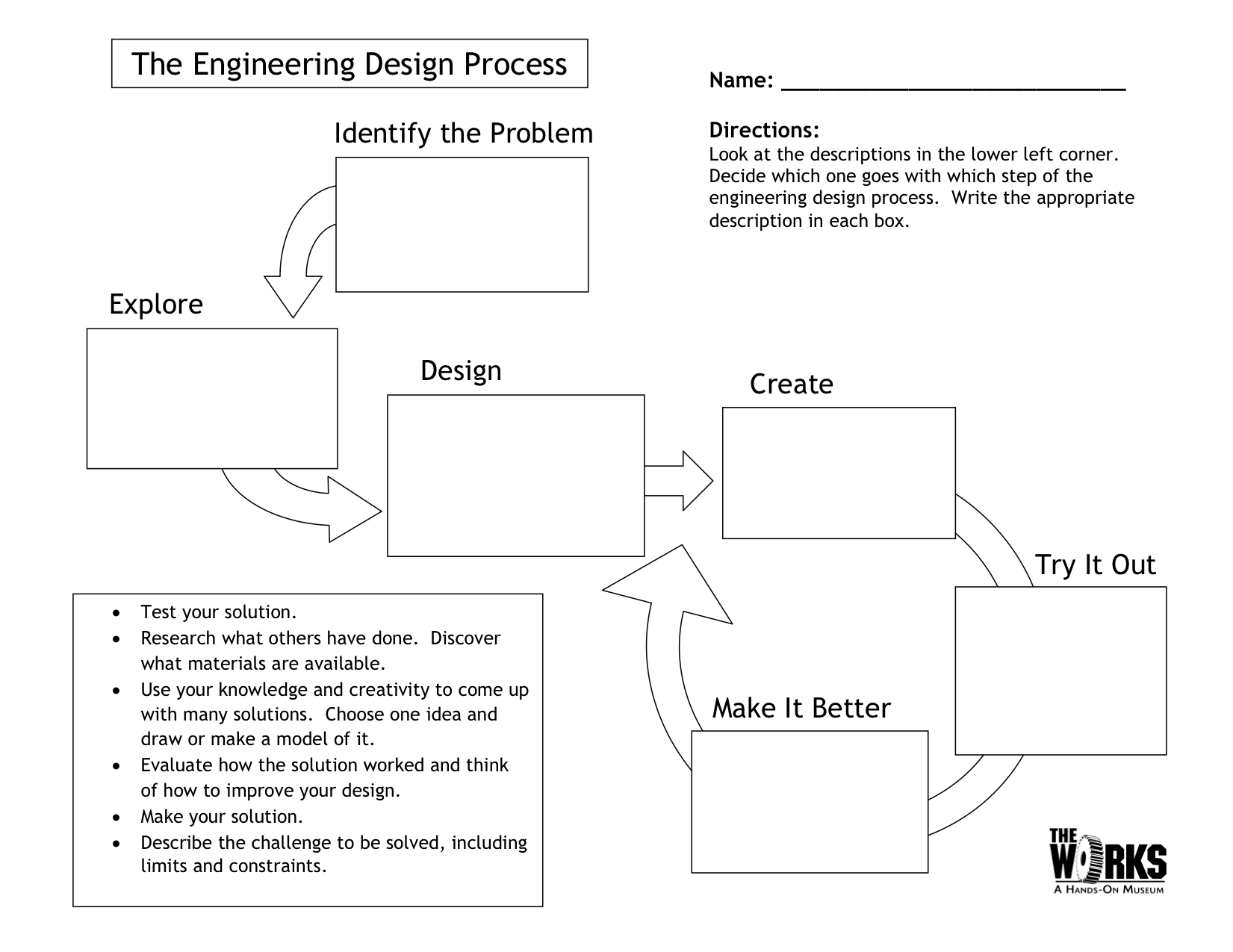Lesson: The Engineering Design Process
 (Lesson courtesy The Works Museum, Minn.)
(Lesson courtesy The Works Museum, Minn.)
Level: Grade 6 (4-8).
Time Required: One class period.
The Works Museum offers teachers three lesson plans and two Powerpoint presentations that can be used before and after a class visit to the museum, each focusing on the engineering design process.
The Engineering Design Process
Overview
This lesson consists of two simple activities aimed at introducing students to the engineering design process and involving them in creative problem solving. Students work through a chart detailing the design process, and then use its steps to consider how to solve one of three problems: rescuing a trapped kitten, devising a way to water plants while on vacation, or rigging up a remote light switch. The two activities are designed to complement each other, yet each can stand alone.
Standards
Minnesota Science – Grade Six
The Nature of Science and Engineering
6.1.2.2.1 Apply and document an engineering design process that includes identifying
criteria and constraints, making representations, testing and evaluation, and refining the design as needed to construct a product or system that solves a problem.
Activity 1: The Engineering Design Process
On the first page of the worksheet, the students are presented with a chart of the engineering design process. The names of the steps are given in the proper order, but the boxes for the descriptions are left blank.
1) Identify the problem
2) Explore
3) Design
4) Create
5) Try It Out
6) Make It Better
Students must apply their knowledge and reasoning to determine which description corresponds with which step, then to write out each description in the appropriate box. This exercise reinforces the idea of a step-by-step design process.
We refer to these steps as “the engineering design process,” but this system can be used for all types of creative problem-solving, from the arts to psychology. The skills learned in engineering are useful in many facets of everyday life.
Answers:
1) Identify the Problem: Describe the challenge to be solved, including limits and constraints.
2) Explore: Research what others have done. Discover what materials are available.
3) Design: Use your knowledge and creativity to come up with many solutions. Choose one idea and draw or make a model of it.
4) Create: Make your solution.
5) Try It Out: Test your solution.
6) Make It Better: Evaluate how the solution worked and think of how to improve your design.
Activity 2: Creative Problem Solving
In the next activity on page two of the worksheet, students are asked to exercise their creative problem-solving skills using the first few steps of the design process as defined by Minnesota Science Standard 6.1.2.2.1: identify the problem, and make representations. (To go beyond that requires making a contraption, which would take more time. In this exercise, students can do some preliminary evaluation without building a device.)
Students’ Worksheet challenge:
The engineering design process helps engineers and other problem-solvers come up with creative solutions. You are an engineer. Choose ONE engineering problem below, and follow the steps to invent a solution.
A. Your new pet kitten is trapped in a ten foot deep hole. You need a contraption to safely rescue your poor animal.
B. You are going on vacation for a month and can’t find anyone to water your plants while you’re gone. You need a device that will give your plants the right amount of water – not too much and not too little.
C. You like to read before you go to sleep, but you don’t have a bedside lamp. You need a way to turn off the light switch across the room without having to get out of bed.
Evaluation and Extension:
1. What problem did you choose? Brainstorm ways to solve the problem and list several possible solutions.
2. Choose one idea. On the back of this page, draw a detailed picture of the solution you chose. Label the drawing to explain what each part is made out of, how the parts fit together, and how it will work.
3. Where do you think you will run into problems with your solution? Where do you think the weak parts in your creation will be?

Notes to the teacher: In doing this activity, students might need more guidance than they receive from the instructions. A good way to offer support is to ask specific, thought-provoking questions that don’t have a “right” answer in mind. For example, suppose the student has chosen to solve problem B: “You are going on vacation and can’t find anyone to water your plants while you’re gone. You need a device that will give your plants the right amount of water – not too much and not too little.”
During the Identify the Problem step, the teacher could ask questions such as:
- How much water does a plant need?
- How often does it have to be watered?
- What are some ways people move water from place to place?
- Could you use gravity, electricity or another force to help you?
- What are some containers you’ve seen water in?
During the Design step, the teacher could ask questions such as (referring to the student’s drawing):
- How does it work?
- What material is this made out of?
- How does this connection work?
- How does this fit together?
- How big is this part?
Teachers may find that some students excel at this activity, while others struggle to generate any ideas at all. Creativity is a difficult skill to teach. At The Works, we believe the best approach is to give students as many opportunities to flex their creative “muscle” as possible, even if the results are meager at first. Creativity is a skill like any other; it takes time to develop it!
Resources
Download further ideas from The Works that suggest ways to integrate engineering into an elementary school curriculum; each is aligned to the 2009 standards.
Learn more about The Works’ teacher resources and outreach programs.
Filed under: Class Activities, Grades 6-8, Grades 6-8, Grades K-5, Grades K-5, Lesson Plans
Tags: Engineering Design Process, Grades 4 - 8, The Works museum









